First big storm of the season and our son Zlatko was already on his way to Northamptonshire. Like all the power company linesmen, he has his own patch, in his case the Forest of Dean, but the teams all rally round when there is damage in another region. For me, there was little enough to do on this first day of winter time. I looked out at the rain drops running down the window pane, re-checked the gauges on-line, brewed coffee and tied a few flies. After seemingly days of rain and with all rivers in flood, clearly there would be no grayling fishing for a while. Appointments with clients had accordingly been delayed; welcome to a day in the uncertain life of a river fishing guide. Meanwhile, as mentioned last month, our local Forest Pool has been closed by Natural England due to a crayfish plague outbreak and it’s anybody’s guess how long the fishing ban might last. Thus there would be no rainbow trout fishing today or possibly all through the winter. Frustrating it is, when there’s no fishing to be had anywhere. Even maintenance on the brooks would not be possible at the moment. Add to this the fact that we were supposed to be moving house during November, but we had just heard that one of the buyers down the chain had backed out at the last moment. In any case I have always hated the business of moving house, a process which seems comparable to entering purgatory. I truly hope that if we ever get it done, this will be the last time.
After a while I put the gun in the Landrover and splashed through deepening puddles on Forest back roads to the Mork shooting ground. This is just a short mile above the Wye at Bigsweir Bridge, tucked into a little side valley, beautiful at any time of the year and even attractive now in the heavy rain. Here, due to the weather a sort of down the line competition had been organised involving firing from the covered terrace of the lodge. I hit some of the rising clays but shot badly at the crossers and felt worse. Confidence or lack of it counts for a lot in shooting. This disgruntled old man was thinking by now about taking up a new hobby. Maybe ditch digging, which might well be in vogue judging by the number of local people who were out today with spades trying to defend their cottages from the rising floods.
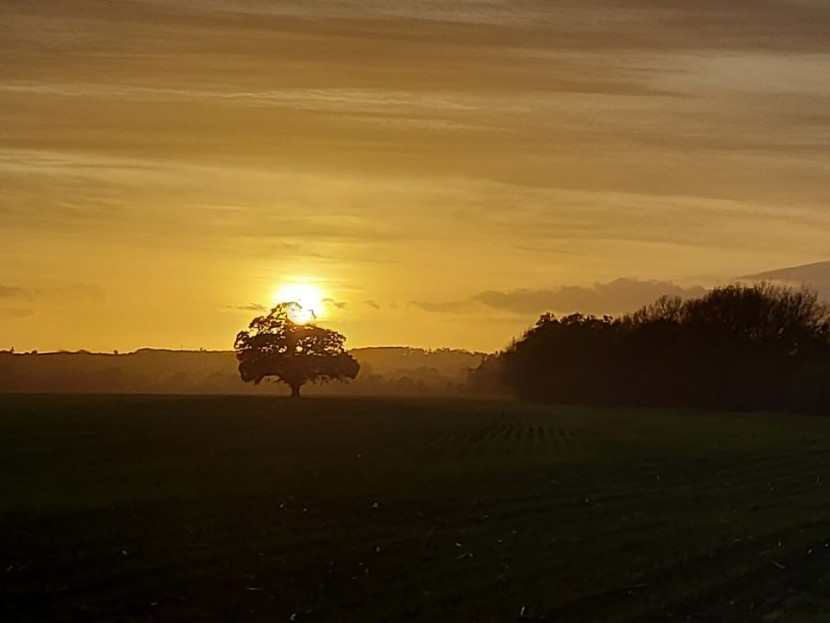 Fownhope - KT from Bath
Fownhope - KT from Bath 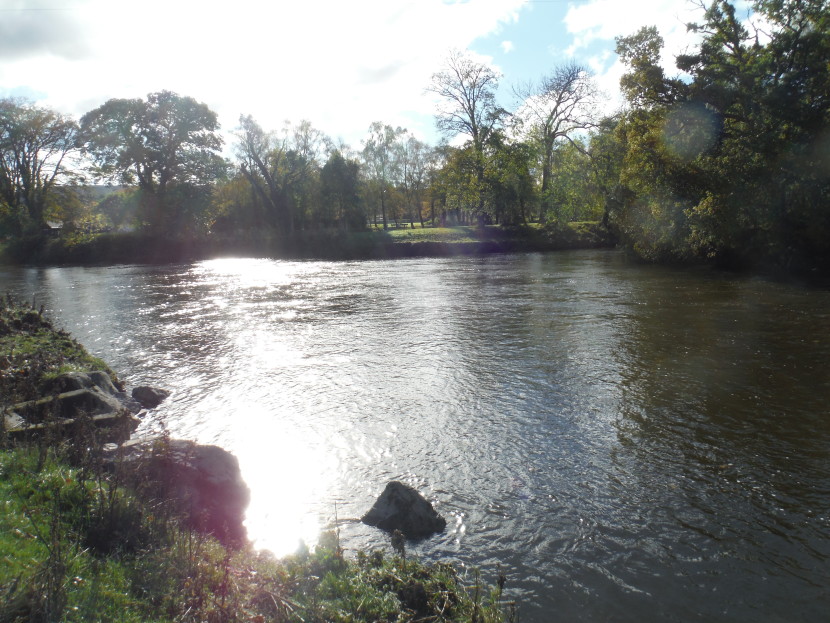 Wye-Irfon junction pool at Builth
Wye-Irfon junction pool at Builth Whatever my mood, I really didn’t plan to indulge in another bout of environmental agency bashing this month. On a daily basis, the English EA and Welsh NRW come in for plenty of stick from many different directions, quite apart from the angling lobby. And most of us know individual staff members who clearly are personally committed to environmental protection and service to the public, yet who all too often find themselves apologising for the weakness of the organisation which employs them. However, right now it is difficult to write about fishing and rivers in our area and remain silent about the failure of environmental protection agencies, who are already experiencing well deserved criticism at both local and international levels.
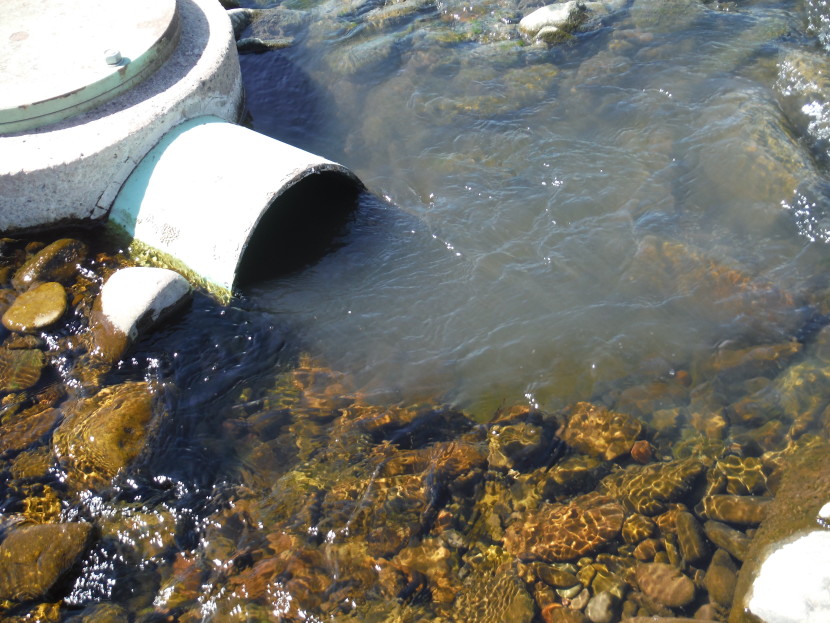 Sewage outflow at Brecon
Sewage outflow at Brecon NRW have just caused immense disappointment by announcing at last that they are not attempting a prosecution in the case of the 2020 pollution of the Llynfi, which resulted in a total kill of fish and invertebrates over 4 kilometres of the stream. See the WUF statement on this. The main reason, as far as I can understand, is that NRW failed to turn up on the scene quickly enough to collect samples of the polluted water which would be of a sufficient scientific standard to ensure a successful court case. Why not, is the obvious question? The Llynfi is, or has been, a most delightful tributary of the Wye. The main stream contained large grayling as well as trout, along with curiosities such as perch and pike in places due to the outflow from Llangorse Lake upstream. The little Dulas tributary draining a side valley is a superb trout stream and both rivers have a good mayfly hatch. We realise that these rivers will recover in time if the pollution is not repeated. However, there seems to be every chance that it will be repeated. Consider that this is the second pollution incident in five years, and again there is no action against the polluter. And yet if you talk to the local country people, they are vociferous in their complaints, including objecting to the continual over-spreading of slurry and anaerobic digester waste on riverside fields and the smell produced by it. And they think they know very well who is responsible for both incidents.
Public attention is currently turned towards other environmental problems at the moment. One very important one concerns the environment bill just passed through Parliament which will among other things regulate the activities of the water companies and OFWAT. I’m referring to the permission water companies have in exceptional circumstances (my italics) to discharge raw sewage directly into streams and rivers. Exceptional circumstances are generally imagined to be times of flood when a lot of water has to be discharged quickly to prevent a backup of the system. However, in recent years “exceptional circumstances” have turned out to occur quite regularly and almost weekly in the case of some sewage treatment works. The Lords added an amendment to the bill which would make it illegal for water companies to discharge raw sewage into the rivers in any circumstances. That, I suppose, is actually what I and others have been calling for over a long time. However, disappointing as it may seem, the Government ordered its MPs to vote against the amendment in the Commons. Although more than 20 Conservative MPs rebelled and voted for the amendment, it was defeated. My own MP voted against the amendment, but at least the problem was being recognised and discussed. To add one extra complication to this situation, the EA has just been successfully challenged by Fish Legal because of advice given to the water industry that, in the case of treatment chemicals being in short supply due to the Covid pandemic, untreated waste could be discharged into certain rivers considered as low risk. Fish Legal argued that this was effectively advice to break the law if needed; the EA then rescinded their advice. I presume none of this was much help to a plant manager faced with a lack of facilities and treatment chemicals with waste water flowing down the pipes towards him.
The problem, as I see it, is that ever since the privatisation of the water industry, we have been under-investing in waste water facilities as the population has expanded. Some very good annual bonuses have been paid out to share-holders, but almost every time a new housing estate is built, pipes are laid in to connect it with the same old sewage works which was designed to serve the area many decades ago. Come to think of it, when did you last see a new sewage farm built? For that matter how many new reservoirs have been built in recent years, rather than using the cheaper options of abstraction and the exchanging of water between rivers? So we now have permitted a situation in which if water treatment works managers are ordered not to discharge untreated effluent into rivers under any circumstances, they will have no other choice but to keep the valves closed and let sewage back up into people’s homes. The question, as I think everybody understands, is how rapidly or how slowly steps will be taken to improve this neglected infrastructure. This all faces me with an admission. Notoriously conservative in my politics as I am supposed to be, I have never been very comfortable with the privatisation of utilities. Some things are just too strategic or too important to be left to the markets. Whoever is going to own the water companies, clearly there is a need for a lot of money to be spent on this not very glamorous but very important system on which we all depend. My long-suffering MP now assures me that, in its final form, the new Act will ensure that water companies declare the true situation about sewage discharges, make rapid strides towards eliminating them and that investment plans to make this possible will be available shortly. Let’s see.
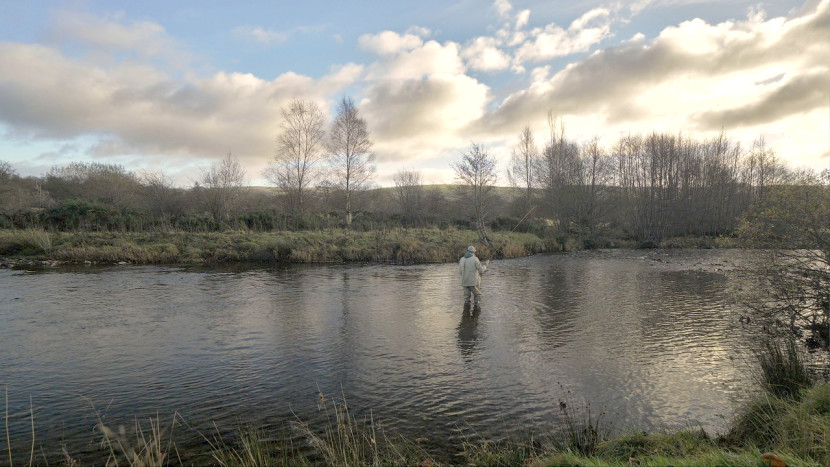 Melyn Cildu - LB from Bude
Melyn Cildu - LB from Bude 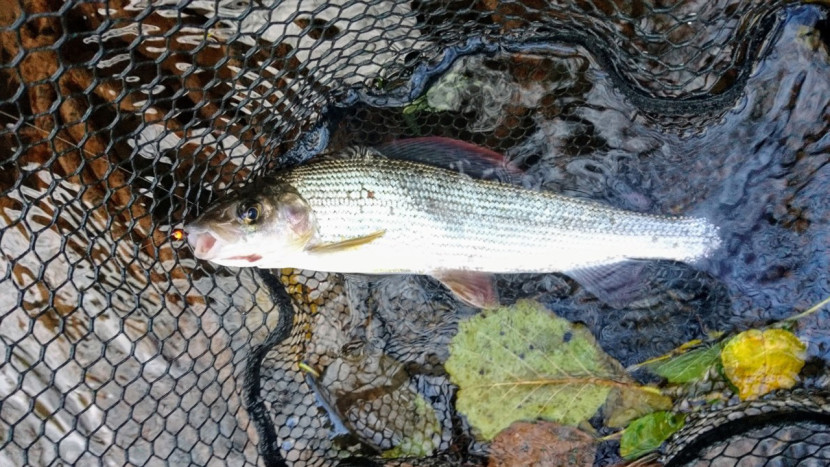 Monnow grayling - RG from Old Sodbury
Monnow grayling - RG from Old Sodbury One other matter is in the public view right now, and this very much concerns the Wye. Local organisations including the Foundation have effectively brought to national attention the problem with phosphate levels, both in the fields of the catchment area and in the water of the river. Thus we have the notorious algal blooms of recent years, along with the death of the ranunculus weed and the creatures which live on it. This problem has arisen quite quickly and follows the recent authorising by the Welsh Government of more than 100 intensive chicken rearing units in the Wye catchment. Millions of chickens living in the upper catchment produce huge amounts of acrid, phosphate-rich manure and to date it has simply been spread on the nearby land. Phosphate is known as a fertiliser of course, but there are limits to how much the land can absorb and use. The surplus just soaks into the rivers. This matter is at least being acknowledged and discussed and I was encouraged to hear the CEO of a large chicken production business the other day suggesting several alternative disposal methods for the manure. On the other hand, as with all these problems, will something actually happen when the talking is done? I cannot imagine an intensive chicken unit being closed by the Welsh Government, any more than I can imagine an off-shore salmon rearing unit being closed by the Scottish Government, although the damage they do to wild salmon and sea trout runs has been known for years. Finally, I will spare you any thoughts on climate change and the COP in Glasgow. I am sure you will have read quite enough on that subject by the end of this month.
Initially November brought us high pressure and the first frost of the year, although the rivers were still slowly running down from high flood. On the 4th when the Llanstephan gauge was still at 2ft 6 inches, I tried trotting from the bank of the Builth town water, running maggots under a float into slacks and eddies. This enterprise was probably undertaken in a spirit of misplaced optimism. I did catch a few grayling, but was more troubled by out of season trout which seemed to be sheltering there, and at one point I realised a large black salmon had moved right under the rod top. Time to move on! Meanwhile chub anglers were having a good time on the lower river and some barbel were also turning up. By the 8th the rivers were starting to come into condition, beginning with the Irfon. BS from Pontyclun had 5 grayling on nymphs at Cefnllysgwynne and oddly enough complained of the Irfon suffering from low water levels, although he quoted a gauge reading of 0.553. I would have said this was high water fishing and that 0.60 on the Cilmery gauge is about the maximum for fly fishing!
CT from Cardiff with 2 friends had a grayling of 2 pounds 4 ounces in a catch of 12 from the Melyn Cildu beat upstream. By now the weather was remarkably warm for November, although that did not generally equate to either late hatching flies or rising grayling. Those of us who had hoped for a sort of extension of October and more dry fly fishing were to be disappointed; the grayling which were caught this month were nearly all accounted for by nymphs or the trotting rod.
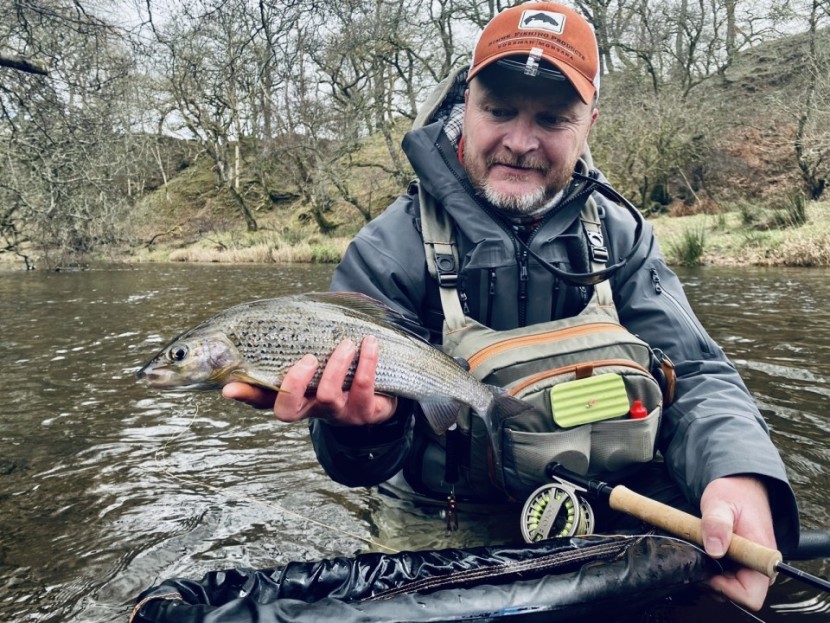 Lyn Davies on Melyn Cildu
Lyn Davies on Melyn Cildu 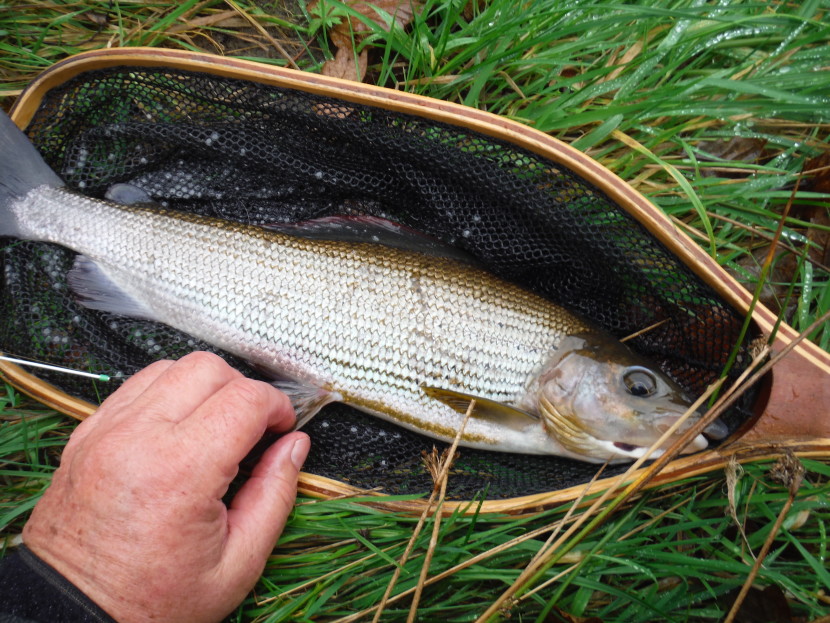 Irfon grayling
Irfon grayling A sudden rise in the Wye on the 10th caught some of us out. This was a surprise, because it hadn’t rained! Students of the strange art of gauge watching might note that, at this time of the year, the river reacts quite quickly to rainfall. This is because the leaves are drying out and falling, while the sap is not rising in the trees. While trees are not sucking up water, what falls on the land goes pretty much straight into the rivers. In this case, the Irfon had not risen and neither had the Ithon. The extra water had come from Llangurig at the top of the main river and we put it down to intense overnight showers in the Cambrian Mountains. The river began to drop again at the rate of about 2 inches a day and on the 13th MN from Bristol reported 10 grayling to 14 inches at Llangoed and Lower Llanstephan.
MB from Abergavenny reported as many as 20 canoes on Craig Llyn the following day. We had a report of two anglers arriving simultaneously to fish the Abbeydore wild stream beat; one had booked it and the other clearly had not. If you have a Wild Stream season ticket, do be careful and check the evening before (as I admit that I have on occasion failed to do) that the beat you have set your heart on fishing is available. JH from Lichfield reported canoeists (legally) launching at the Rectory and remarked on their politeness, which is always much appreciated when experienced. On the 15th PB from Upton-on-Severn caught 5 grayling while trotting at Lyepole. He was one of several anglers who commented that, perhaps compared to more familiar nymphing methods, trotting isn’t always as easy as some imagine, especially in small streams! I had a try myself on the new Irfon beat at Melyn Cildu; I couldn’t find lots of grayling, but there were three big ones apart from unwanted trout. AB from Hereford with 4 friends had a difficult day coarse fishing on the Dean and Chapter Pool, but reported that it was so warm that the bats were out in numbers at dusk. PK from Gloucester was using a single small Pheasant Tail Nymph at Skenfrith on the 17th, and caught 7 grayling. RG from Old Sodbury tried the same Monnow beat with various nymphing methods on the 19th and had a dozen grayling to 15 inches along with a couple of chub. AB from London tried the new trotting regime at Eyton and accounted for 13 grayling. He also reported changes in the level and colour of the Lugg during the day, which, given the lack of rain in the area at the time, seems odd. I had the same experience when fishing here a couple of days later; the Lugg suddenly coloured up for a while during the early afternoon, which made me wonder if works of some kind are going on upstream. There are a few open runs for the float fisher at Eyton, but mostly it’s a matter of “picking pockets” here and there. There is certainly a good population of grayling of different sizes.
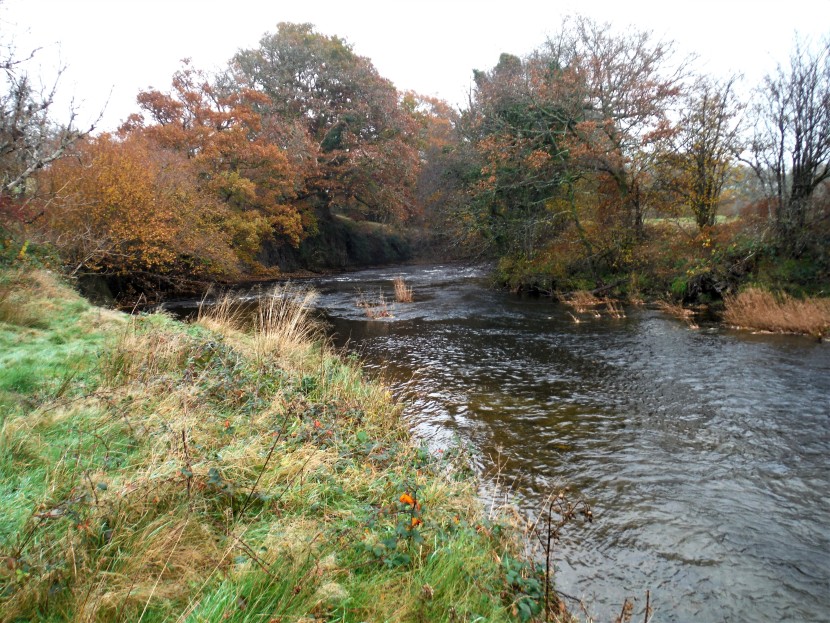 Upper Irfon at Melyn Cildu
Upper Irfon at Melyn Cildu 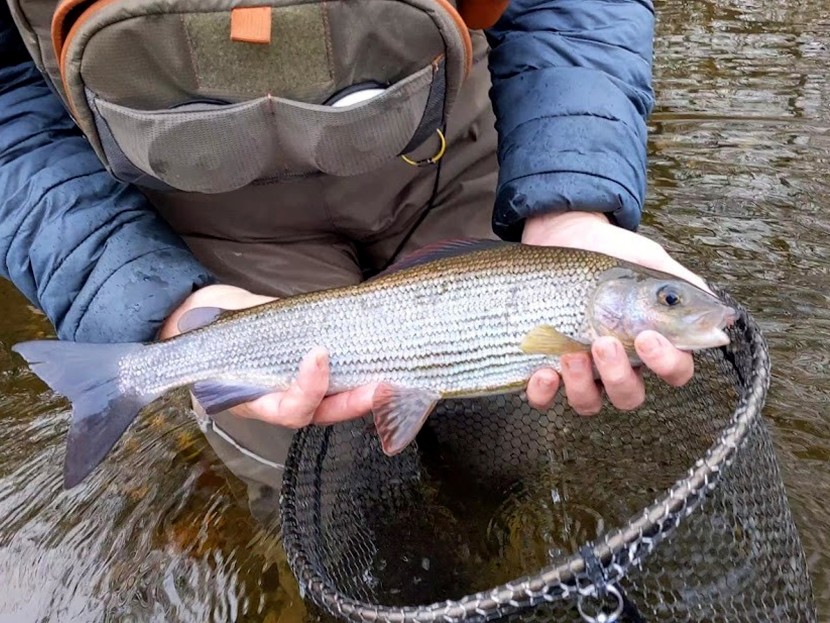 Melyn Cildu grayling - CT from Cardiff
Melyn Cildu grayling - CT from Cardiff By this time the weather had turned quite abruptly, the wind having swung to the North, bringing wintry temperatures with it from the Arctic. Days were bright and sunny, but chilly too, and we had regular morning frosts. The coarse fishermen on the lower Wye were not doing so well with the barbel now, but chub still featured in cold water catches. Meanwhile salmon had been present on the spawning flats for several weeks, but not many redds were to be seen yet. AG of Harleston, Norfolk, fished the Dee with nymphs at the Glyndwr Preserve on the 22nd and accounted for 23 grayling to 15 inches. The favoured “bug” was apparently a Purple Perdigon, the French nymph almost entirely constructed of coloured resin hardened with an ultra-violet lamp. DC from Jackfield, Telford, was another to fish the new Irfon beat at Melyn Cildu the following day, and amongst his seven grayling were four between 1lb 15oz and 2lb 3 oz – “a dream session for me.” We all seem to have had the same experience here - not that many grayling and certainly not smaller grayling, but a few real specimens. Back on the main river, MH from Swansea reported 8 grayling from the Rectory taken on a Goldbead Hare’s Ear nymph. On the 25th PS from Kingsland fished at Ty Newydd, which he found busy with canoeists launching in the Bachawy Run, and while fishing the “klink and dink” duo method accounted for a dozen small grayling. Interestingly, most of them were on the “klink” dry fly, which certainly bucked the trend for November.
Another big equinoctial storm started to blow up the next evening, this one code-named “Arwen,” and in its nature both cold and rough. I will write something about gales and storms next month. Conditions out of doors were still difficult with low temperatures and high winds on the 27th, but MH from Swansea came back to the Rectory and caught 11 small grayling on various weighted nymphs. The upper Wye rose a foot, but quickly fell. November fishing was sometimes difficult, but by the end of the month we had received reports of quite good grayling catches and certainly some specimen fish, more from the tributaries than the main river. Trotting was a new feature for some of the tributary beats. I saw quite a few salmon in the Wye during November, although perhaps not so many in the tributaries as you might expect. It’s to be hoped that the current cold spell will trigger more widespread spawning activity. At the same time we began to receive reports of diseased fish, particularly in the nearby River Tawe where numbers of dead salmon and sea trout have been found badly infected with the saprolegnia fungus. After spawning this would not be unusual as the process involves immense stress on the fish and kills many of them, but if before spawning it is yet more bad news.
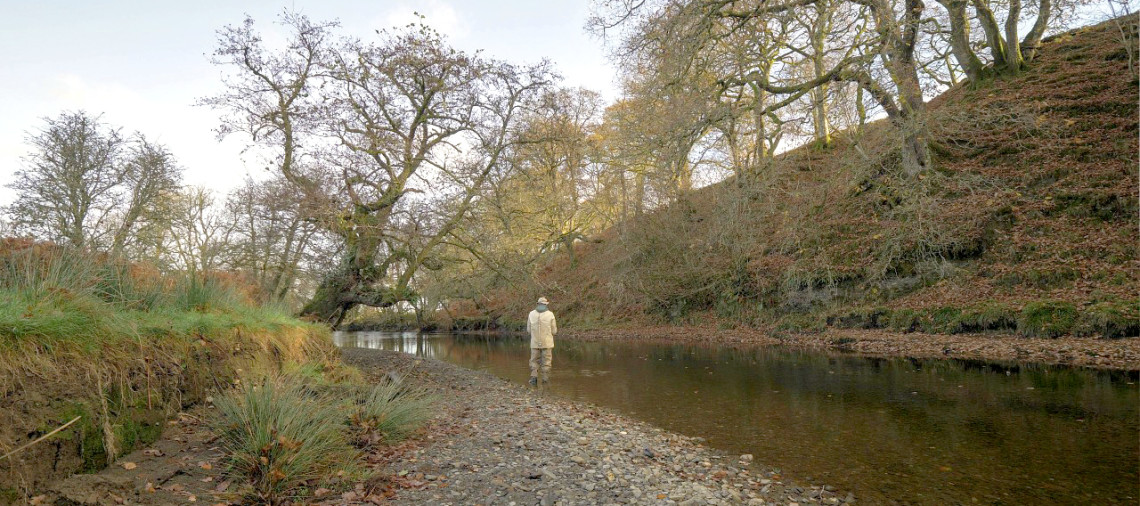 Upper Irfon low and clear - LB from Bude
Upper Irfon low and clear - LB from Bude It’s unusual, these days, to come across a UK-based professional fly dresser. Of course this is a profession with a venerable tradition and the names of some of the great fly dressers of the past – Foster, Hammond, Woolley – deserve to rank with those of the great anglers and innovators in our sport. Very often the invention of a really remarkable fly which is now standard in the canon was the result of a collaboration between a competent angler and a skilled fly dresser. Greenwell’s Glory would be the classic example. The problem today for the fly dressing profession is that nobody has ever really found a way to automate the labour-intensive process and that, when tying down to a price, it’s very difficult to make much money out of it. I would guess that around 50% of modern game anglers who become seriously engaged with the sport take to tying their own sooner or later. Doing so adds a huge dimension to the pleasure of the whole activity. But others will be buying from the commercial market, very likely patterns for which the actual dressing work is farmed out to somewhere like Kenya. Some of these, such as the patterns of Fulling Mill, are very good and made from excellent materials. Others, unfortunately, are not. There are in truth some quite awful flies out on the market, usually over-dressed, over-coloured and constructed on unreliable hooks. It’s a mystery to me why an angler would spend significant sums on his travel to the river or lake, his fishing ticket and his rod, reel and line, only to save 50p by using a cheap, badly constructed fly on the business end.
Gary Holt lives in the Irfon valley, fishes some of our local rivers and has been dressing flies for 30 years. He tells me he occasionally gives fly tying demonstrations at the Cammarch Hotel in Llangammarch Wells. I only recently came across his activities as a professional dresser – blame me for that - but friends and I have been extremely impressed by his website – see www.myflieswetsanddries.co.uk. Apparently he ties everything, from nymphs to salmon and salt water flies, with materials which look to me to be of high quality and, equally important, well-chosen and proportionately applied. Believe me, the prices are fair. Gary’s catalogue includes both old standards and new patterns; why not give some of them a try?
Gary’s “Irfon Bug” is one which intrigues me. It seems to have the right characteristics: dull-coloured, even slightly scruffy. I have a theory that the best fishing flies are relatively easy to make and a bit like this, which is indeed to say dull-coloured and slightly scruffy. My own flies are scruffy alright, and nothing like as neatly finished as Gary’s seem to be. I sometimes think that a good fishing fly is a little bit like an old-fashioned policeman. What do I mean by that? Well, at one point in a rather idiosyncratic career, I worked for a man who had formerly been an inspector in the Hong Kong Police anti-corruption squad. I seem to remember him describing certain experienced CID officers as “…old school, a bit scruffy, probably a bit corrupt – but good thief-takers!” I think fishing flies should be like that: good fish-takers!
You may find this a bit of a surprise, but there’s a particular book which I believe thinking river anglers of all disciplines would be well advised to read, and perhaps read more than once. This is Salmon Taking Times, which RV Righyni published back in 1965. Reg Righyni, of course, became famous for writing the classic Grayling a few years later, and among grayling anglers his name and memory are pretty much revered as he is seen as the father of the modern sport. However, Salmon Taking Times made much less of an impact and many dyed in the wool salmon specialists declare themselves baffled by some of the things he has to say in this work. I will admit to being baffled by much of it too, but that is very likely my fault. There is no doubt that Righyni was a very good salmon angler and that he had a knack of somehow knowing when salmon would and wouldn’t take. His book is an attempt to make sense of that “somehow.” Bear in mind that Righyni fished the Lune and various Scottish rivers in the days when a lot more salmon were present, which would certainly have given him opportunities for experiment. Falkus was another who claimed to have the “knack of knowing in advance” when the magic moment would come, but in his case he made no real attempt to rationalise it.
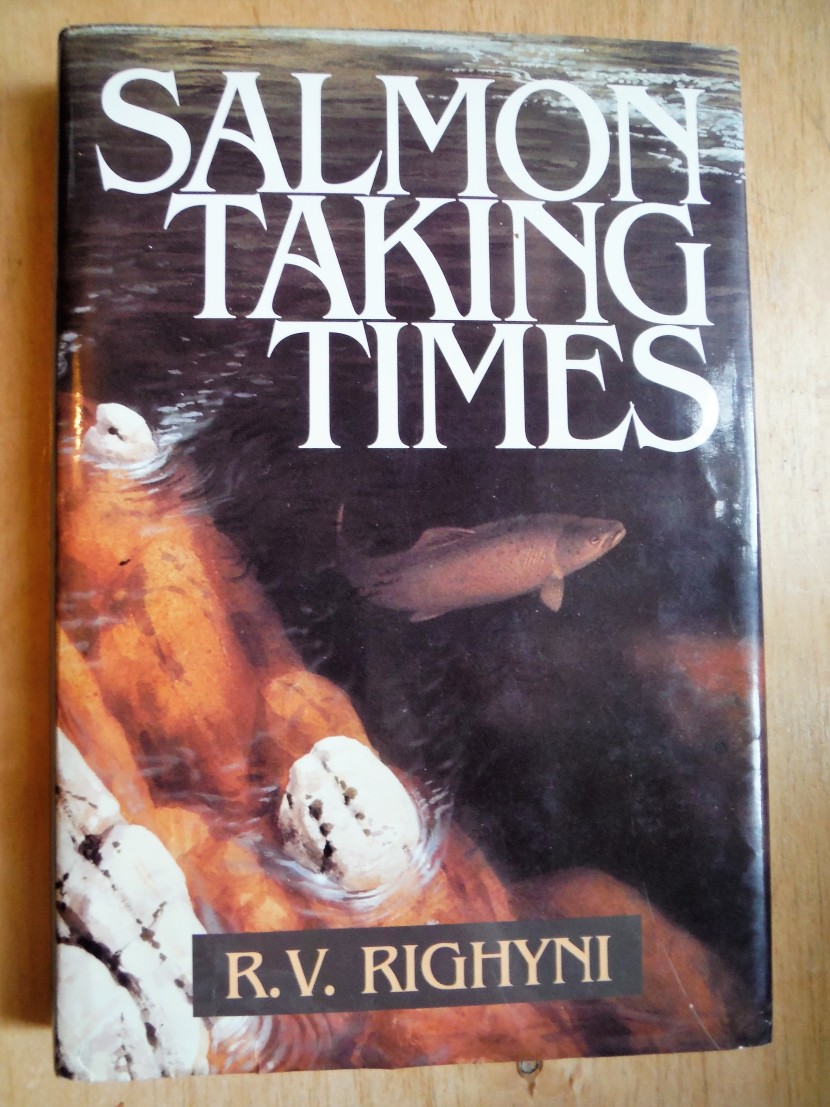 Righyini on salmon
Righyini on salmon Salmon Taking Times has an introduction by Bernard Venables, in which he describes a visit Righyni made to fish the Hampshire Avon with him. It’s generally accepted that fishing for salmon on chalk streams is quite a different business from fishing on the more normal rain-fed rivers, mainly because the familiar riffle, pool, glide sequence is largely absent. It was Righyni’s first attempt to fish the Avon, which he described as “nearly all glide,” but he surprised Venables by making the prediction that nothing much would happen before 5 o’clock, and he also suggested several places on glides where he thought a take would occur. Sure enough, nearly exactly at 5 and in one of the indicated places, a large salmon head and tailed over the fly and took it. Understandably Venables was impressed. I would have been.
A lot of us have our ideas about when river fishing will be good, quite apart from the obvious matter of water height and clarity. This applies to most types of angling, not just salmon fishing. Thus we know we like a soft grey light, cloud cover, moderate air and water temperatures, maybe a little drizzling rain would not hurt our chances. On the other hand a hard light, bright sun, high pressure and cold east wind are all factors we could do without. You hear people talk about the amount of foam which collects in eddies, large amounts tending to indicate the day will be poor for taking salmon. Foam, I suppose, is probably affected by changes in air pressure, a subject on which Righyni had much to say. Righyni (and Falkus too) went on to argue that when the river bank is somehow lively, with birds moving and singing, that is also the right time for a response from a salmon. I can only contribute an experience of my own that those days when “unwanted” fish such as trout and chub seem to be taking an interest in the salmon fly, for whatever reason, those are also the days when salmon are likely to take it. And vice versa.
However, these descriptions of “right” and “wrong” days are all pretty vague. Righyni proposes a much more scientific explanation than that. Essentially “The Theory” as Venables rather reverentially describes it is all about the accessibility to the salmon of dissolved oxygen in the water. If the fish is receiving either too little or too much dissolved oxygen, it will be “off” the take. When it has the right amount, it will be “on” the take. The problem for the angler is that is very difficult to know or predict when the accessibility of dissolved oxygen will be right, because so many factors affect it from hour to hour. These include water temperature, acidity, aeration by waterfalls, surface aeration due to wind, availability of lies and their position related to the current, oxygen and carbon dioxide production from weeds by day and night, air temperature and humidity, and finally atmospheric pressure. Does the last factor sound familiar? There have been much-publicised recent writings on the subject of barometric pressure and taking salmon, and even the offer of a wrist instrument for anglers to check it while fishing. However, this is not exactly a new idea and Righyni was certainly propounding it nearly 60 years ago. The theory is basically that the angler does better when the barometric pressure is either steady or rising. It’s interesting to read about this subject on the salmon fishing forums, where correspondents are split into two schools of thought. There are those who do claim a rising barometer brings them success and some of these have even bought the watch. And there others who advise along these lines: “Don’t bother with all that nonsense as you will only frustrate yourself. Just go out and fish in favourable conditions and be thankful that the odd occasional salmon does take a fly.”
I confess to an attraction to the second school of thought and I’m sure that salmon and sea trout have taken me with the barometer falling on occasions. In fact there are those who will tell you that falling barometric pressure makes salmonids extra aggressive. However, Righyni has written another chapter which should not only be of interest to salmon anglers. This is Reading River Currents: the behaviour of water. A shorter title might have been simply “hydraulics.” I don’t think another writer has attempted anything quite like this, and although Righyni’s explanations and diagrams in this case are easy to follow, in fact almost blindingly obvious, it is very useful stuff for those of us who spend long hours wading in rivers to understand. Thus Righyni explains that the best way to understand the action of currents in a pool is to put your head close to the surface and look upstream, that rough water running into the head of a pool is affected by gravity but the smooth flow accelerating at the tail is subjected to suction. He also explains the reasons why large, medium and small stones are deposited in different places, eddies and back washes, the actions of scouring and deposition, and why bank erosion occurs in sometimes unexpected places. The book is worth reading for this section alone and anyone who fishes free-stone rivers for trout and grayling as well as salmon should find it valuable. There is a final section from the Usk angler Terry Thomas who makes a series of comments on Righyni’s findings. Salmon Taking Times has been reprinted by Swan Hill Press.
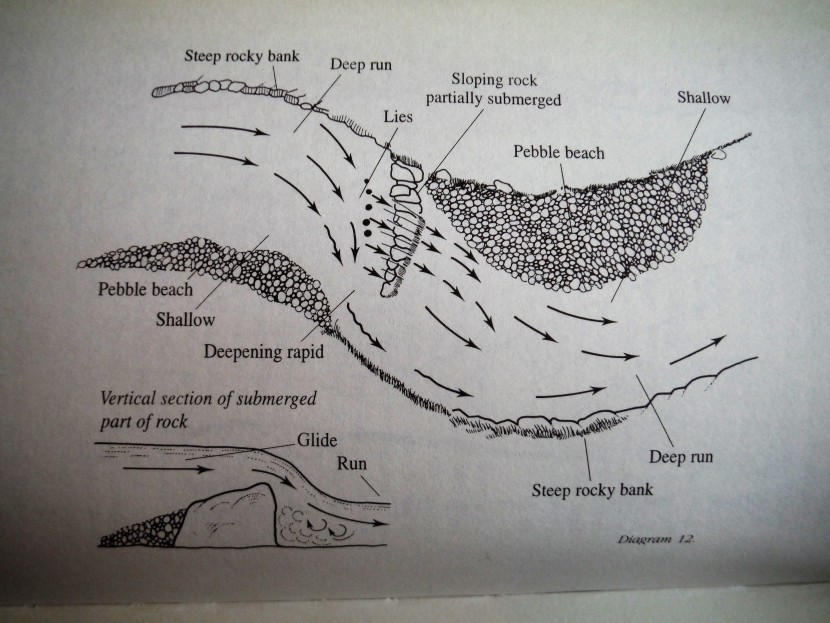 Righyni on hydraulics
Righyni on hydraulics 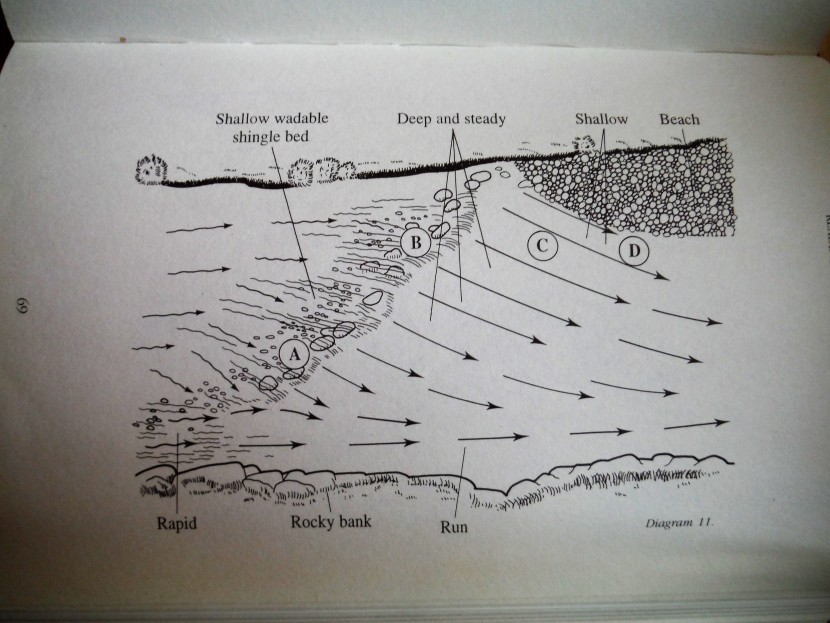 Righyni on the way a river runs
Righyni on the way a river runs 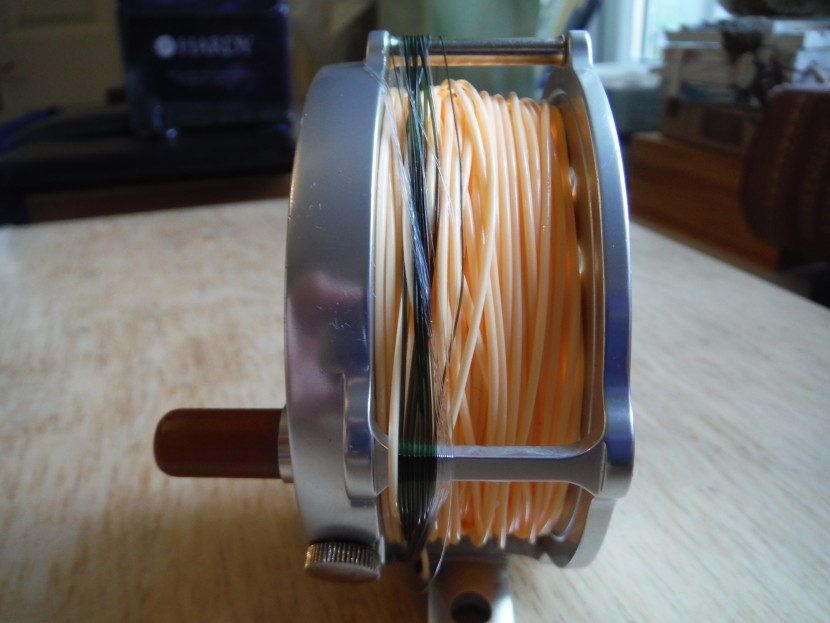 Pillared construction and the leader left out
Pillared construction and the leader left out By the way, a couple of people wanted to know exactly what I meant last month by leaving the leader “outside the pillars” of a reel between trips. This suggestion really presupposes a full cage reel, rather than the half cage reels more common nowadays. See the photograph for what I tried rather inadequately to describe; that’s a 15 foot tapered leader wound round the outside. Just don’t mess with the handle until the reel is mounted back on the rod again and the leader strung through the rings.
Every Armistice Day we see an explosion of red poppies in our Forest towns. Still they come out to lay the wreaths, young and old, the Sea Scouts and the Army Cadets, and elderly members of the British Legion in dark blazers with their medals. We are a long way now from “Flanders fields”; this is after all the 100th anniversary of the Royal British Legion. Given the passage of time and the fact that this is Gloucestershire, any surviving direct memories of suffering, imprisonment or lost comrades are today connected with the Battle of the Imjin River, or more likely Bosnia, Iraq or Afghanistan, rather than the earlier World Wars of the 20th Century. However, the Armistice or Commemoration Day traditions, here at least, are as strong as ever.
 Symbols - poppies and the protecting Hand of Fatima
Symbols - poppies and the protecting Hand of Fatima Our daughter spends most of her working time providing medical and dental services to men and women of the armed services. As such, military drills and parades are not a very regular part of her daily life. Even formal saluting tends to be left aside on some bases, and there are good reasons for that. However, this year she was selected with a small group to represent her Corps in the British Legion’s commemorative festival and service at the Albert Hall. This was to be in the presence of the Royal Family, the PM and other representatives of the great and good. She confided in me that she was terrified of somehow screwing up, spoiling the solemn mood of the occasion by a clumsy mistake. In particular there was that matter of the march down the stairs into the arena. What if one should stumble or trip?
I know exactly how she felt and I would surely feel the same. I remember my friend Mike from Canadian Battalion, “Canbat” as we knew him more familiarly in Bosnia, who after a few beers would tell the story of commanding a group of pall-bearers given the task of carrying the coffin of a fallen comrade due to be flown home. All they had to do was transport the coffin across a field at a slow march to the tarmac where a military transport aircraft was waiting with the rear cargo door open, then carry it up the ramp and put it down. Off they set at a deliberate and synchronised pace. Unfortunately, nobody had thought to make an exact check of the ground to be covered. In the middle or lowest part of the field, the ground became softer and softer until it turned into something like bog. They came to a halt with the six carriers up to their calves in Bosnian mud and unable to move forward or back, still with the coffin and its Canadian flag on their shoulders. Eventually all seven involved had to be rescued. As Canbat put it, the departed was the sort of chap who would have found the situation amusing, which was perhaps fortunate.
In this case, there was plenty of opportunity to practice marching down the stair cases of the Wellington Barracks. Guardsmen must be practising this all the time. As a civilian who spent a lot of time around military units, I was intrigued by some of the tricks and wrinkles employed to make parading easier. The little hook sewn into the tunic to take part of the weight of the rifle. Knowledge that standing very still for long periods leads to a loss of blood from the head and sometimes fainting, so that small unseen movements must be made to keep the circulation going. When it came down to the event, there were two full rehearsals, one dress rehearsal, and then two actual performances in the Albert Hall on 13th November. Adrenalin counted for a lot accorded to Medina and two days of mingling with the other participants, from bandsmen to veterans, bereaved families and Chelsea Pensioners, was an honour. I was working on the river that day, but I got to see it on television that evening. Medina and her colleagues’ descent into the arena came after that of the Grenadier Guards, so it was quite an act to follow. They were still unseen inside the doorway when the massed bands began to play Soldiers of the Queen, a signal to begin tramping on the spot and swinging their arms to get the march rhythm, after which with great panache Major Das in his green Sikh’s turban led them out and down the steps to line up before the drum-head altar and so the service could begin. All went well. And nobody stumbled on the stairs of the Albert Hall. During the two minutes of silent reflection, the poppies fell continually and gently past hats and uniforms to the ground.
One thing I have learnt in my life is that when societies become divided, symbols risk becoming hi-jacked to serve causes which had never been intended. To me the poppies and Armistice Day ceremonies are symbolic of respect for the sacrifices of the past and certainly of patriotism, but not, as some people rather sadly seem to be feeling and declaring today, of narrow minded nationalism. I find that idea very depressing. And in the same way mosques to me are representative of the kindliness and humanity of Islam, but not of religious extremism. After the parade I picked my daughter up from Chepstow at 3 in the morning, tired, but quite moved by what she had seen and heard. I am sure she will remember the evening and its falling poppies into her old age. November was a happy time for her, because later that week she got engaged, to a sergeant in the RAMC. And later still we heard that the people who want to buy our house had found somebody else to buy theirs, so the chain is re-established. I guess it wasn’t such a bad month after all and life goes on.
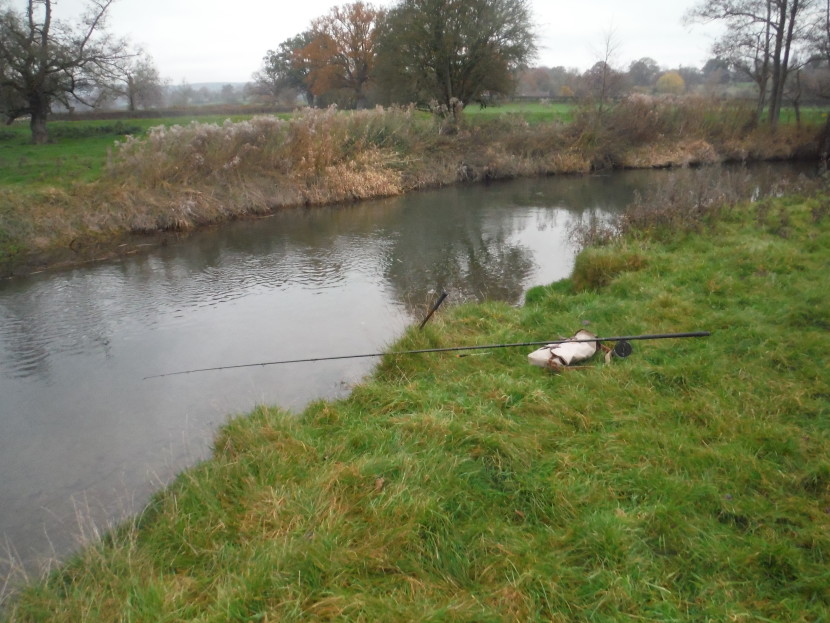 Trotting stream at Eyton
Trotting stream at Eyton 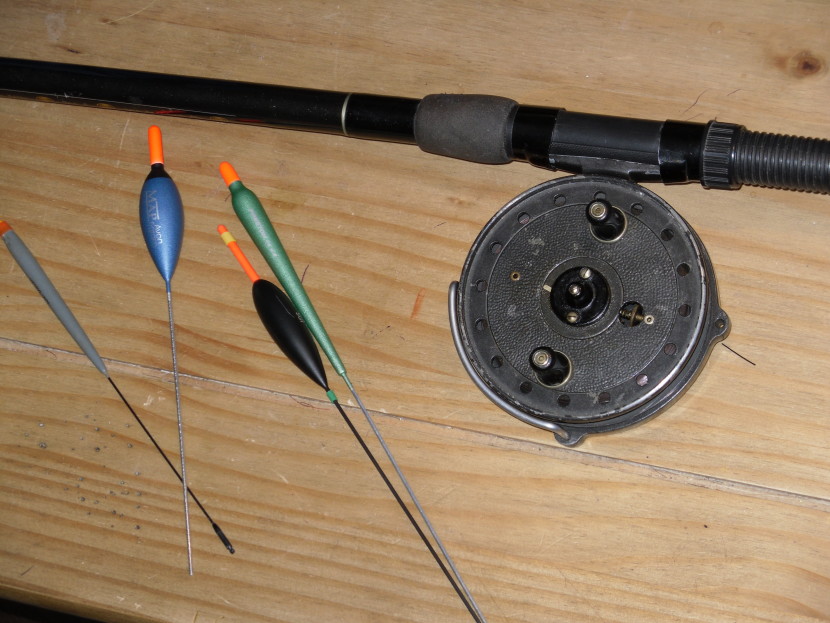 Tools for trotting
Tools for trotting 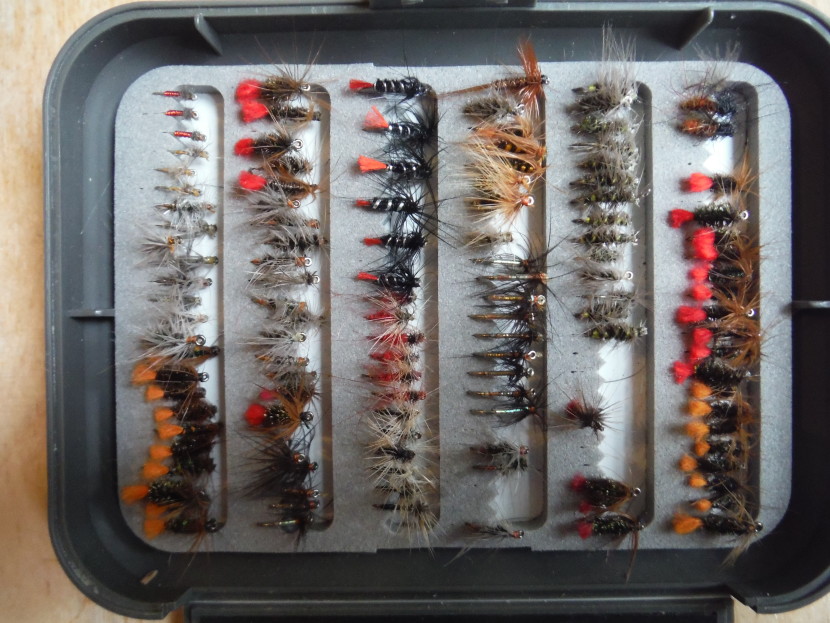 Some old fashioned wet flies
Some old fashioned wet flies